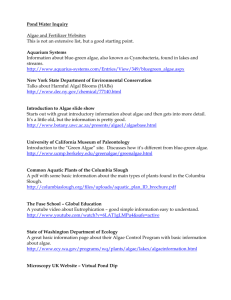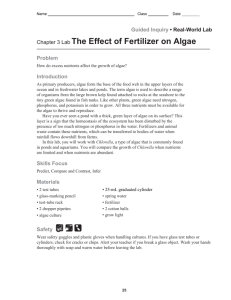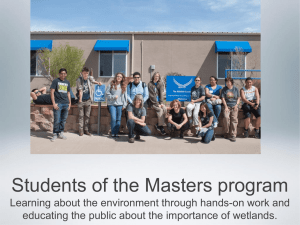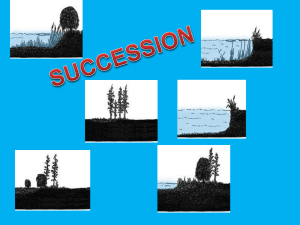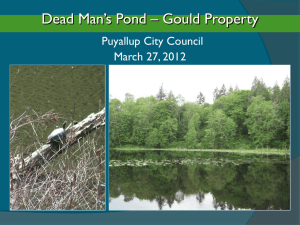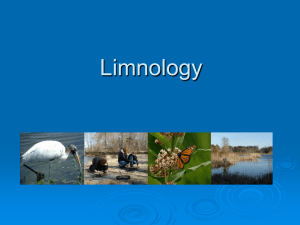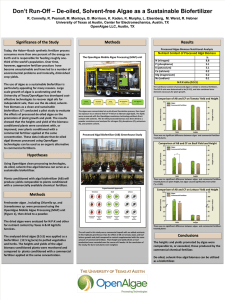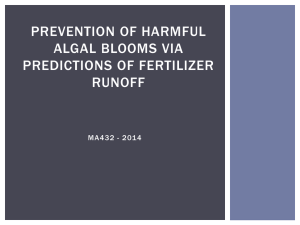FREE-RESPONSE QUESTIONS Chapter One
advertisement
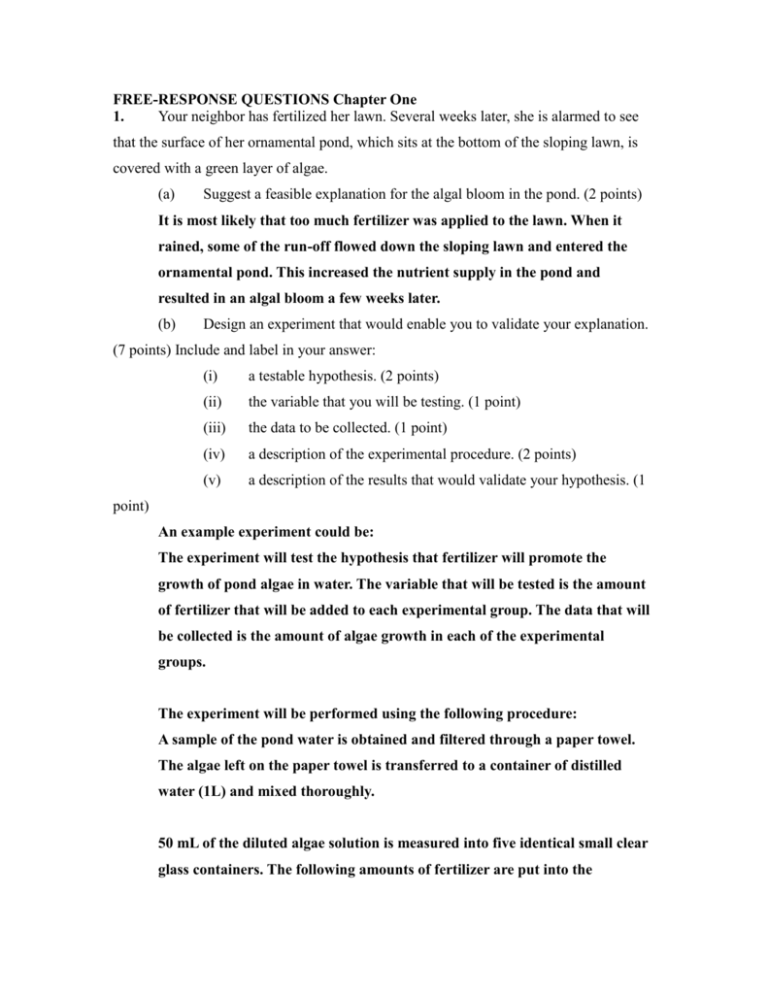
FREE-RESPONSE QUESTIONS Chapter One 1. Your neighbor has fertilized her lawn. Several weeks later, she is alarmed to see that the surface of her ornamental pond, which sits at the bottom of the sloping lawn, is covered with a green layer of algae. (a) Suggest a feasible explanation for the algal bloom in the pond. (2 points) It is most likely that too much fertilizer was applied to the lawn. When it rained, some of the run-off flowed down the sloping lawn and entered the ornamental pond. This increased the nutrient supply in the pond and resulted in an algal bloom a few weeks later. (b) Design an experiment that would enable you to validate your explanation. (7 points) Include and label in your answer: (i) a testable hypothesis. (2 points) (ii) the variable that you will be testing. (1 point) (iii) the data to be collected. (1 point) (iv) a description of the experimental procedure. (2 points) (v) a description of the results that would validate your hypothesis. (1 point) An example experiment could be: The experiment will test the hypothesis that fertilizer will promote the growth of pond algae in water. The variable that will be tested is the amount of fertilizer that will be added to each experimental group. The data that will be collected is the amount of algae growth in each of the experimental groups. The experiment will be performed using the following procedure: A sample of the pond water is obtained and filtered through a paper towel. The algae left on the paper towel is transferred to a container of distilled water (1L) and mixed thoroughly. 50 mL of the diluted algae solution is measured into five identical small clear glass containers. The following amounts of fertilizer are put into the containers and mixed thoroughly: 0.00 g into container 1 0.25g into container 2 0.50g into container 3 0.75g into container 4 1.00g into container 5 The above steps are repeated another three times to use up all of the 1L of the algae mixture and providing a total of four experimental groups. That is, the experiment is repeated four times. The containers with no (0g of) fertilizer represent the control group. Each of the labeled glass containers is placed on a sunny windowsill and monitored on a daily basis. The glass containers are compared for algal growth by assessing the green coloration of each container. (This could be done qualitatively as described above and/or compared to the color of 50ml of water taken directly from the surface of the pond with the algal bloom OR quantitatively by using a colorimeter if one is available.) It is expected that between 3 and 7 days, depending on the amount of sunlight, more algal growth will be evident in the containers that have fertilizer added to them. The amount of algae will depend on the amount of fertilizer that was added—the more fertilizer, the more algae. This result validates the hypothesis that fertilizer will promote the growth of pond algae in water. This also helps to validate the explanation in (a) above. (c) Based on the data from your experiment and your explanation of the problem, think of, and suggest, one action that your neighbor could take to help the pond recover. (1 point) It may be difficult to get the pond to recover immediately due to the high level of fertilizer that was added to the lawn. The algae growth may continue until all the fertilizer has run-off from the lawn. The neighbor should NOT apply any more fertilizer to the lawn. She needs to use a soil test kit and assess the nutrient levels of the lawn. Using a mulching lawn mower will help restore nutrient levels naturally. The algae in the pond could be harvested or scooped off when it is in a quantity that enables this to occur. This could also be done in conjunction with drawing down the level of the pond water and replacing it with freshwater. This will help dilute the nutrient level in the pond. She could also plant vegetation on the side of the pond that is facing up the slope. This will help reduce nutrient input from run-off water when it rains, as the nutrients will be taken up by the plants before run-off enters the pond. 2. The study of environmental science sometimes involves examining the overuse of environmental resources. (a) Identify one general effect of overuse of an environmental resource. (3 points) Possible answers could include cutting down trees, which leads to massive erosion. Other answers could be loss of soil, which causes food production to decrease, and overuse of needed water resources. (b) For the effect you listed above, describe a more sustainable strategy for resource utilization. (3 points) Possible answers could include any of the sustainable development ideas from page 12. For example, practices such as conserving and finding alternatives to nonrenewable resources as well as protecting the capacity of the environment to continue to supply renewable resources. Recycling and reuse are other possible answers with a suitable discussion of the strategy. (c) Describe how past events from Easter Island can indicate environmental issues on Earth today. (4 points) Answers can include a discussion of how environmental scientists believe that there are limits to the supply of clean air and water, nutritious foods, and other life-sustaining resources our environment provides. They also feel there is a point at which Earth will no longer be able to maintain a stable climate. FREE-RESPONSE QUESTIONS Chapter Two 1. The atomic number of uranium-235 is 92, its half-life is 704 million years, and the radioactive decay of 1 kg of 235 U releases 6.7 1013 J. Radioactive material must be stored in a safe container or buried deep underground until its radiation output drops to a safe level. Generally it is considered “safe” after 10 half-lives. (a) Assume that a nuclear power plant can convert energy from 235 U into electricity with an efficiency of 35 percent, the electrical transmission lines operate at 90 percent efficiency, and fluorescent lights operate at 22 percent efficiency. (i) What is the overall efficiency of converting the energy of 235U into fluorescent light? (2 points) 0.35 0.90 0.22 = 0.069 or 6.9% efficiency (nuclear decay to electricity) (transport of electricity) (fluorescent light efficiency) (ii) How much energy from 1 kg of 235U is converted into fluorescent light? (2 points) 6.7 1013 joules/kg 0.069 (1 kg U-235) = 4.6 1012 joules (iii) Name one way in which you could improve the overall efficiency of this system. Explain how your suggestion would improve efficiency. (2 points) Some ways that could improve the efficiency of this system would be to use the waste heat or decrease the heat and sound lost as the energy is being transported from the plant to the light. (b) What are the first and second laws of thermodynamics? (2 points) The first law of thermodynamics states that energy cannot be created or destroyed, but it can be converted from one form to another. This explains how it is possible to take the energy from the fission of Uranium-235 and convert it to energy used in fluorescent lighting. The second law of thermodynamics states that when energy is transformed, some of that energy is converted to a less usable form, usually heat, and the capacity of that energy to do work diminishes. This explains why no conversion from one energy form to another is 100% efficient and less usable energy is available for applications such as the fluorescent light. (c) How long would it take for the radiation from a sample of 235 U to reach a safe level? (2 points) 10 half-lives 704 million years/half-life = 7,040 million years or 7.04 billion years 2. U.S. wheat farmers produce, on average, 3000 kg of wheat per hectare. Farmers who plant wheat year after year on the same fields must add fertilizers to replace the nutrients removed by the harvested wheat. Consider a wheat farm as an open system. (a) Identify two inputs and two outputs of this system. (4 points) Possible inputs: Water Sunlight Seeds Fertilizers Pesticides Gasoline (to run machinery) Land (space) Soil Possible outputs: Food Seeds Air pollution Water pollution (b) Using one input to and one output from (a), diagram and explain one positive feedback loop. (2 points) There are many possible answers; two examples are provided. Results in Increased Water Supply + Increased Food Production Requires An increase in water supply will result in more crops and higher food production, which then requires more water to continue increased food production. OR Results in Pesticide use Fewer Pests + Results in an increase in Results in More Pests Increased Crop/Food Production Provides more food for Pesticide use reduces the number of pests resulting in an increase in crop production, which provides more food for more pests that necessitates the use of more pesticides. (c) Identify two adaptive management strategies that could be employed if a drought occurred. (2 points) Possible Adaptive Management Strategies: Plant fewer crops Replant specific areas with prairie grasses for ground cover to prevent erosion Divert water from other areas not affected by the drought Import water (i.e., truck it in from distant areas) Use water that has been stored from previous nondrought years Switch to a crop that requires less water (xeriscaping) Leave land fallow (d) Wheat contains about 2.5 kcal per gram, and the average U.S. male consumes 2500 kcal per day. How many hectares of wheat are needed to support one average U.S. male for a year, assuming that 30 percent of his caloric intake is from wheat? (2 points) kcal consumed by male from wheat = 2500 kcal/d (365d 0.30) = 2.74E5 kcal kg wheat required per year = [2.74E5 kcal/2.5 kcal/g] (1 kg/1000g) = 110 kg per year hectares needed = (1 ha/3000 kg)(110 kg) = 0.037 ha
